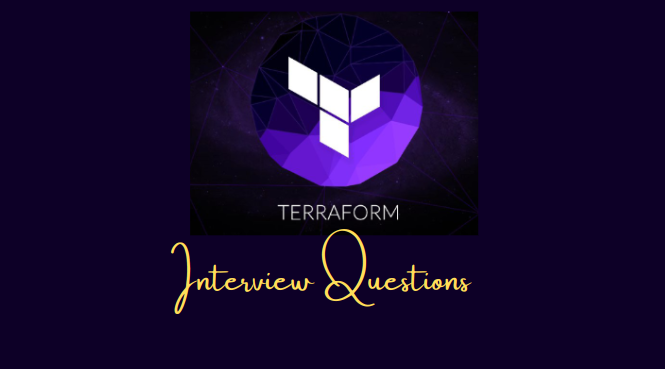DevOps, Day - 71
 Vrishni Shree V B
Vrishni Shree V B
What is Terraform and how is it different from other IaaC tools?
Terraform is an Infrastructure as Code (IaC) tool used for defining and provisioning infrastructure resources in a declarative and version-controlled manner. It allows you to define infrastructure using a simple and human-readable configuration language and then apply those configurations to create, modify, or destroy resources in cloud providers or on-premises infrastructure.
Differences from other IaC tools:
Declarative Configuration: Terraform uses a declarative approach, where you define the desired end state, and Terraform figures out how to reach that state. Some other tools use an imperative approach.
Resource Graph: Terraform creates a resource graph that shows resource dependencies, enabling efficient parallelism in resource provisioning.
Wide Provider Support: Terraform supports a wide range of cloud providers and services, making it versatile.
State Management: Terraform maintains a state file to track the current state of the infrastructure, which is helpful for updates.
Community and Ecosystem: Terraform has a large and active community, resulting in extensive module and provider support.
How do you call a main.tf module?
- In Terraform, there is no specific naming requirement for the main configuration file. "main.tf" is a common convention, but you can use any name for your main configuration file. Terraform will automatically recognize and apply configurations from all
.tffiles in the same directory.
- In Terraform, there is no specific naming requirement for the main configuration file. "main.tf" is a common convention, but you can use any name for your main configuration file. Terraform will automatically recognize and apply configurations from all
What exactly is Sentinel? Can you provide a few examples where we can use Sentinel policies?
Sentinel is a policy as a code framework developed by HashiCorp. It allows you to define and enforce policy rules for infrastructure provisioning in Terraform. Examples of Sentinel policy use cases:
Security Policies: Enforce security rules, such as requiring encryption for data storage, limiting network access, or ensuring the use of specific authentication mechanisms.
Compliance Rules: Ensure that infrastructure configurations adhere to compliance standards and regulations, like PCI DSS or HIPAA.
Resource Naming Conventions: Enforce naming conventions for resources to maintain consistency.
Cost Control: Implement policies to control and monitor infrastructure costs, such as limiting the use of expensive resources.
Change Control: Define rules for change management, like requiring approvals for modifications to critical infrastructure.
You have a Terraform configuration file that defines an infrastructure deployment. However, there are multiple instances of the same resource that need to be created. How would you modify the configuration file to achieve this?
- You can use meta-arguments like
countorfor_eachto create multiple instances of the same resource. These arguments allow you to specify the number of resource instances or a map of resource configurations to create the desired number of resources. You define the common resource configuration and then use the meta-arguments to replicate it.
- You can use meta-arguments like
You want to know from which paths Terraform is loading providers referenced in your Terraform configuration (*.tf files). You need to enable debug messages to find this out. Which of the following would achieve this?
A. Set the environment variable TF_LOG=TRACE
Setting
TF_LOGtoTRACEwill enable debug-level logging, including information about where Terraform is loading provider plugins from.
The below command will destroy everything that is being created in the infrastructure. Tell us how would you save any particular resource while destroying the complete infrastructure.
To save a particular resource while destroying the entire infrastructure, you can use the
-targetoption with theterraform destroycommand. For example:terraform destroy -target=module.example.aws_instance.example_instanceThis command will destroy all resources except the one specified in the
-targetflag.
Which module is used to store the .tfstate file in S3?
The
terraformmodule with thebackendconfiguration is used to specify the storage location for the Terraform state file (.tfstate). To store the state file in Amazon S3, you configure thebackendblock like this:terraform { backend "s3" { bucket = "my-terraform-state-bucket" key = "path/to/my/terraform.tfstate" region = "us-east-1" } }
How do you manage sensitive data in Terraform, such as API keys or passwords?
Sensitive data can be managed in Terraform using data sources, environment variables, or external secret management tools like HashiCorp Vault.
Avoid hardcoding sensitive data in your configuration files.
Use variables to accept sensitive values from environment variables or prompt for input.
Store secrets securely using external tools like Vault and access them using data sources.
You are working on a Terraform project that needs to provision an S3 bucket and a user with read and write access to the bucket. What resources would you use to accomplish this, and how would you configure them?
To provision an S3 bucket and a user with read and write access, you can use the following resources and configurations:
aws_s3_bucketresource: Define the S3 bucket's properties, including its name, access control, and encryption settings.aws_iam_userresource: Create an IAM user.aws_iam_access_keyresource: Generate access keys for the user.aws_iam_user_policyresource: Attach a policy to grant read and write access to the S3 bucket.
Configure the IAM user and policy to allow actions like
s3:ListBucket,s3:GetObject,s3:PutObject, etc.
Who maintains Terraform providers?
- Terraform providers are maintained by their respective providers, which are often the cloud service or infrastructure technology companies themselves. For example, the AWS provider is maintained by Amazon Web Services, and the Azure provider is maintained by Microsoft. These providers are usually open-source and may have contributions from the community as well.
How can we export data from one module to another?
In Terraform, you can export data from one module to another using output variables. Here's how it works:
In the source module, define an output variable using the
outputblock, specifying the value you want to export.In the calling module, use the
modulereference to access the output variable from the source module.
Example: Source module (source_module/main.tf):
output "example_output" {
value = "This is an example value."
}
Calling module (calling_module/main.tf):
module "source" {
source = "../source_module"
}
output "exported_value" {
value = module.source.example_output
}
In this example, exported_value in the calling module will contain the value "This is an example value" from the source module.
Thank you so much for reading
Follow me on LinkedIn to see interesting posts like this : )
Subscribe to my newsletter
Read articles from Vrishni Shree V B directly inside your inbox. Subscribe to the newsletter, and don't miss out.
Written by

Vrishni Shree V B
Vrishni Shree V B
💻 Python | Docker | Jenkins | Networking | Git | Linux 💻 Passionate about leveraging technology to drive efficiency and deliver innovative solutions. Proficient in Python development, Docker containerization, Jenkins automation, computer networking, Git version control, and Linux administration. Skilled in collaborating with diverse teams to deliver high-quality software products. Proficient in AWS EC2 instance management and deployment. Seeking new opportunities to apply my expertise and contribute to impactful projects. Let's connect and explore how we can work together! Inter-personal Skills: Communication, Adaptability, Emotional intelligence, Active listening, Collaboration. Happy To Connect🔗😊 Feel free to reach me out😃@ --> vrishnishreevb531@gmail.com 📬